Shopify is a powerful platform for electronic stores, offering the tools needed to leverage these trends and provide a top-notch shopping experience. With Shopify, you can easily set up your store, offer flexible payment options, and provide personalized customer service.
In this blog, we'll provide a tutorial on setting up a successful Shopify electronic store.
I. Why choose Shopify to build your electronics store?
Is Shopify the best choice to build an online eclectronic store? Let's find out the key points.
1.1. Benefits of using Shopify for an electronics store
Ease of Use
-
User-friendly interface: Shopify's intuitive interface makes it simple to set up and manage your store, even if you're not tech-savvy. Easily add products, update descriptions, and manage inventory without hassle.
-
Theme options: Shopify offers a variety of free and paid themes that are easy to use, even without coding or technical knowledge.
Scalability
As your electronics business grows, Shopify scales with you. Advanced features like bulk inventory management and automated order processing simplify handling larger volumes of products and sales.
-
Flexible plans: Shopify offers numerous business plans for businesses of all sizes. You can start with a basic plan and upgrade later without extensive research or changes.
-
24/7 support: Shopify provides round-the-clock customer support, ready to assist with any issues specific to running an electronics store. This includes managing high-value transactions and troubleshooting technical product listings.
Convenient App Integrations
-
Enhance functionality: Access a vast app marketplace to enhance your store's functionality with specialized apps. Integrate features such as product reviews, warranty management, and technical support chatbots to improve customer service and build trust with buyers.
-
Marketing tools: Shopify themes come with built-in marketing tools, such as email marketing and in-menu promotion, to help store owners maximize their marketing efforts.
-
Third-party apps: The extensive app store includes third-party apps like ShipperHQ and Smart Insure to meet diverse store owner needs.
1.2. Key Components of a Successful Shopify Electronics Store
- User-friendly design:
The store should have a clean, intuitive interface that is easy to navigate. Creating a well-designed and functional electronics store is crucial for attracting customers and driving sales. This includes mobile optimization to ensure a seamless shopping experience across all devices.
For new store owners, beginning with a standard theme and focusing on product sales is key, rather than prioritizing design. Install Google Analytics to monitor changes and their impact on your store effectively.
- High-quality product presentation
Clear, high-resolution images and detailed product descriptions are crucial. Customers should be able to easily understand product features, specifications, and benefits.
- Secure payment options
Offer multiple payment gateways that are secure and easy to use. Customers should feel confident about the safety of their transactions.
- Customer support
Provide excellent customer service, including responsive support for inquiries, order tracking, and returns. A positive customer experience encourages repeat purchases and builds brand loyalty.
II. How to Start a Shopify Electronics Store in 2024
First you should choose a business model suitable for your electronics store, like drop shipping or standard e-commerce.
Step 1. Create Shopify account & Add basic information
Visit the Shopify website and sign up for an account. Follow the prompts to set up your store.

You should also add and change some information such as:
- Online store name and contact information
- Legal name and business address
- Store time zone
- Store currency
- Display multiple currencies
- Default weight unit
- Home page metadata
- Order IDs
Step 2. Choose a domain Name
Select a domain name that reflects your brand and is easy for customers to remember. Use Shopify's domain checker or WHOIS domain lookup to see if your desired domain name is available for purchase.
Then, set up your account and configure DNS settings. Register your chosen domain through Shopify.
They automatically handle DNS configuration for domains bought through them. If using a third-party registrar, manually update DNS settings in their control panel.
Once DNS settings are configured, add your domain to Shopify through the Admin panel under Settings > Domains.
Step 3. Add vital information
It's also crucial to input essential details in the backend.
-
Shipping Information: Enter accurate shipping details including zones and rates. Set up shipping profiles for different product types and customer locations to manage shipping costs effectively.
-
Tax Settings: Configure tax settings based on your business location and compliance requirements. Shopify can automate sales tax calculations, but verify settings regularly to ensure accuracy, especially for locations with specific tax regulations.
-
Payment Gateways: Activate Shopify Payments or choose alternative payment providers based on availability in your region. Review eligibility requirements and set up necessary bank accounts for payment processing.
Step 4. Adding products to your store
Adding products is a crucial step in setting up your Shopify store. Click on “Products” and then “Add product” within your Shopify admin.
Provide details such as product titles, descriptions, and media, ensuring the use of high-quality images and adding alt text for accessibility. Set pricing, inventory details, and shipping information.
Remember to activate the product and manage its visibility across different sales channels to optimize your product’s reach and availability.
Step 5. Selecting and customizing a theme
Choosing the right theme is crucial for creating a professional and engaging storefront.
First, access your Shopify admin panel using your credentials. From the Shopify admin sidebar, click Online Store. Under Online Stor*, select Themes. This will show the currently installed themes.
To find new themes, click on Explore free themes or Visit Theme Store. Here, you can browse through a wide selection of free and paid themes.
You can preview different themes to see how they look and function. Once you find a suitable theme, click on it to see more details. If you decide to use a theme, click on Add theme to add it to your Shopify store. After adding a theme, you can customize it according to your brand’s needs by adjusting colors, fonts, layout, and more.
Once customized, click Publish to make the theme live on your store
Here are some top themes suitable for electronics stores.
Impact by Maestrooo
Known for its modern and minimalist design, ideal for showcasing high-tech products with a focus on visuals and functionality.

Cello by Webibazaar Templates
Ideal for Shopify stores aiming for a sleek, modern look. It's tailored for electronics or fashion businesses, featuring a clean layout that enhances product display and user experience.
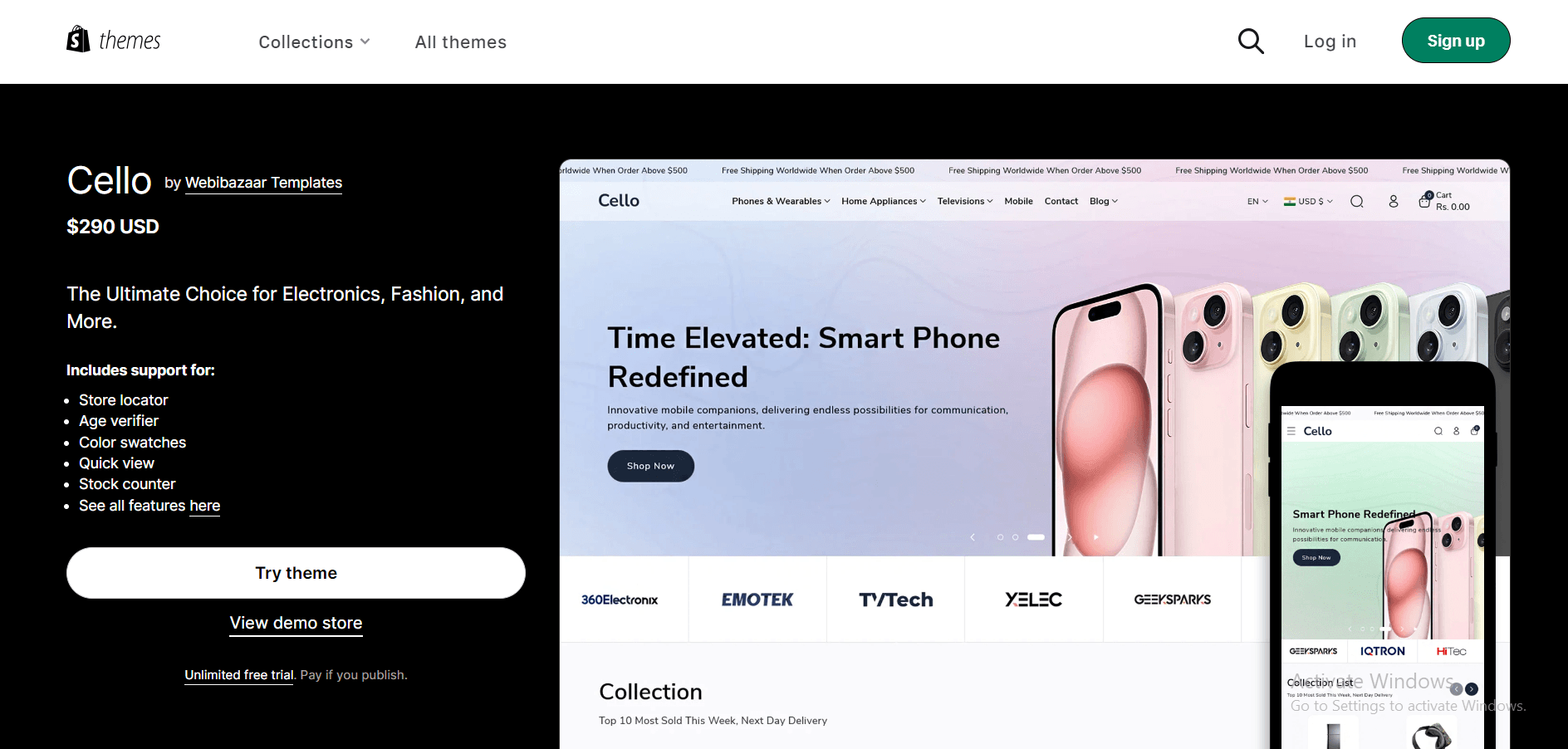
Next by Someone You Know
A theme that combines simplicity with flexibility, featuring clean lines and a responsive design that adapts well to various devices.
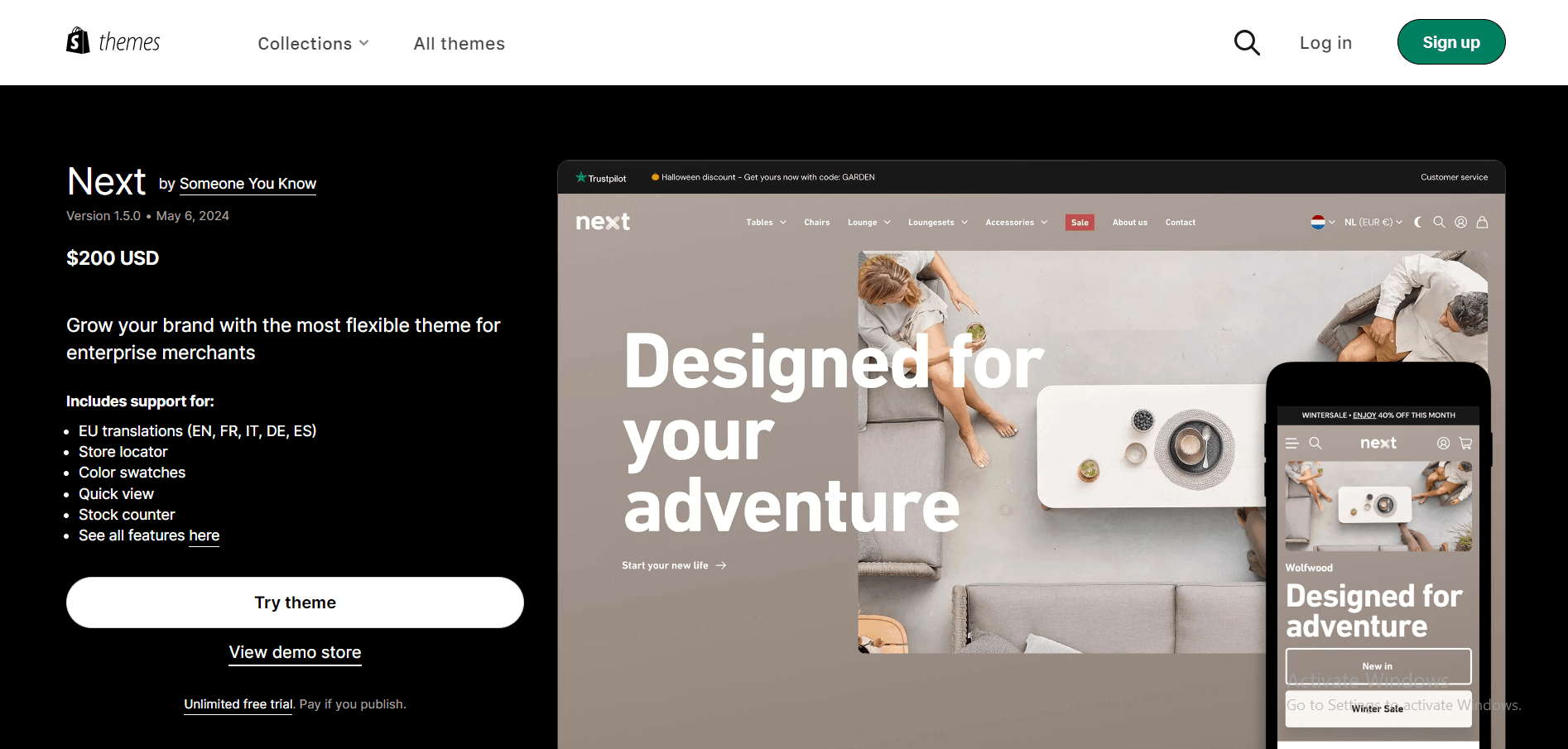
Digital by Segment
Tailored for digital and electronics stores, this theme emphasizes clarity and ease of navigation, enhancing the user experience.

Stockmart by Segment
Provides a clean and professional look, focusing on usability and aesthetics to effectively showcase a wide range of electronics products.

Step 6. Design your website
Customizing your Shopify store's design is crucial for creating a cohesive and engaging online presence. Tailor your theme to reflect your brand identity. Adjust colors, fonts, and layout elements to ensure consistency throughout your site.
To effectively customize your Shopify store’s layout, focus on these key areas to effectively tailor your store's layout
- Designing your homepage:
Your homepage is the first impression customers get of your brand. Make it impactful by ensuring clear messaging and visible calls to action (CTAs).
You should also highlight best selling products with compelling descriptions and imagery and inncorporate trust badges to enhance credibility and encourage conversions.
- Creating key pages:
Develop essential pages that build trust and provide information such as About Us to share your brand’s story and values, Contact to provide easy ways for customers to reach you, Policy Pages page to include shipping, returns, and privacy policies to establish transparency.
Also, the Blog page is a crucial page to engage customers with valuable content, industry insights, and updates related to your products and brand.
Customizing navigation menus:
Optimize navigation for seamless user experience by using Shopify’s Navigation page to add, remove, or edit menu items.
Create intuitive menus that direct users to products, collections, and important pages. Lastly is to consider drop-down menus for complex navigation structures.
Key Note:
While traditionally building a website using Shopify's admin offers robust features and ease of use, considering a headless approach opens up new possibilities for flexibility and customization.
Headless Content Management Systems (CMS) decouple the frontend presentation layer from the backend infrastructure, allowing you to deliver content across various platforms and devices seamlessly. This approach not only enhances the agility of your website but also provides greater control over user experiences and integrations.
TrueStoreFront is specialized in providing service similar to frontend-as-a-service (FEaaS) solutions, including ready-made themes like OWEN for Shopify. If you're interested in a headless approach, our expertise ensures that your Shopify electronics store is both functional and visually appealing, meeting the demands of modern ecommerce.
Step 7. Marketing
Implement marketing strategies to drive traffic and sales to your electronics store.
-
SEO Optimization: Use relevant keywords and optimize metadata to improve your store’s ranking in search engines, enhancing visibility and attracting organic traffic.
-
Social Media Integration: Leverage platforms like Instagram and TikTok to boost brand awareness and drive traffic through integrated shopping features. These platforms allow direct purchases from social media posts, enhancing customer engagement and potentially increasing sales (social commerce).
Before launching your Shopify store, ensure you've covered these essentials:
- Functional Check: Confirm all website functionalities, especially the shopping cart and checkout process, to minimize cart abandonment.
- Credibility Pages: Polish critical pages like ‘About Us’ and ‘Privacy Policy’ to establish trust with your customers.
Before going live, conduct a final review to double-check the website's functionality, addressing any potential issues that could disrupt the visitor experience. Optimize your site for SEO by strategically integrating relevant keywords and metadata.
This proactive approach will enhance your store's visibility on search engines from the outset, attracting more potential customers and optimizing your launch success.
III. Enhancing your electronic store with Shopify apps
Shopify offers essential apps to enhance operations, customer experience, and sales for electronics stores. These apps are crucial in a competitive market where customer expectations are high and technology evolves rapidly.
| Shopify Apps | Characteristics |
| Estimated Delivery Date - ETA | Purpose: Displays clear shipping estimates on product pages, cart, and checkout. Features: Customizable delivery dates based on product, location, and more. Benefits: Builds trust with transparent shipping information. |
| GemPages: Landing Page Builder | Purpose: Simplifies design with customizable templates for home, product, and landing pages. Features: AI-guided layout creation, conversion boosters like countdown timers. Benefits: Increases sales by creating visually appealing, high-converting pages. |
| Vitals: Reviews, Upsells & 40+ | Purpose: Consolidates essential sales tools including reviews, upsells, and marketing features. Features: Product reviews, upsell bundles, real-time marketing notifications. Benefits: Enhances customer trust and increases average order value. |
| Geolocation - Orbe | Purpose: Tailors shopping experience based on visitor location, adjusts currency and language. Features: Customizable geolocation popups, market selector. Benefits: Expands global reach and improves customer experience. |
| AfterShip: Order Tracking | Purpose: Provides branded order tracking pages and real-time delivery updates. Features: Automated notifications, AI-powered estimated delivery dates. Benefits: Reduces customer inquiries and enhances post-purchase experience. |
| S: Call For Price & Hide Price | Purpose: Hides product prices to encourage inquiries, enhancing personal engagement. Features: Price request forms via email, WhatsApp, or call. Benefits: Increases lead generation and customer interaction. |
| Trustoo.io: Product Reviews App | Purpose: Collects and displays customer reviews with photos and videos. Features: Customizable review widgets, automated review requests. Benefits: Enhances credibility and encourages purchase decisions with social proof. |
| CM Commerce: Email Marketing | Purpose: Automated email campaigns to engage customers and reduce cart abandonment. Features: Customer segmentation, personalized email campaigns. Benefits: Improves customer retention and boosts sales through targeted marketing. |
| Referral Candy & Affiliate | Purpose: Implements referral and affiliate programs to drive customer acquisition through word-of-mouth. Features: Automated referral programs, customizable rewards. Benefits: Increases customer loyalty and expands customer base through referrals. |
IV. Essential features for Shopify electronics stores
To ensure your electronic store works seamlessly, you need to consider adding several crucial features in the following:
- Advanced inventory management:
Manage large volumes of electronic products efficiently with Shopify's robust inventory management tools. Features like bulk editing, automated stock updates, and low-stock alerts help streamline operations.
- SEO tools:
Shopify provides built-in SEO features to help optimize your store for search engines. Customize meta titles, descriptions, and URLs to improve visibility and attract organic traffic.
- Product variants:
Electronics often come in various models, colors, and specifications. Use Shopify's product variant options to display different versions of your products clearly and manage inventory efficiently.
V. Maximizing performance with analytics and optimization
To maximize your Shopify store's performance, utilize analytics and optimization strategies effectively
- Use google analytics:
Ensure you have Google Analytics set up to track all aspects of your store’s performance. This includes visitor behavior, conversion rates, and the impact of changes made on your site.
- Using Shopify analytics tools:
You can consider using the Monitor Performance tool to track key metrics such as visitor traffic, conversion rates, and average order value. Also, the Identify Trends is one of the best tools to analyze trends in customer behavior and sales data, which help you understand what’s working and where improvements are needed.
- Tracking key performance metrics (KPIs):
Use Focus Areas to track metrics related to product pages, checkout process efficiency, and the effectiveness of your marketing campaigns. KPIs can identify bottlenecks and optimize the customer journey for improved conversion rates.
- A/B testing
You should experience and conduct A/B tests on different elements of your store, including product pages, checkout processes, and marketing strategies. Then, use test results to make data-driven decisions that enhance user experience and increase sales.
- Gathering customer feedback
Surveys and reviews help you collect customer feedback to understand their satisfaction levels and identify areas for improvements. It also allows you to tailored your offering based on customer insights, then enhance the whole customer experience.
- Monitoring analytics and optimizing:
Regularly review analytics data to spot trends and make informed adjustments to your strategies. Optimization based on analytics insights helps maintain competitiveness and business performance.
VII. Real-world examples of Shopify electronics stores
Let's grab a quick look at the overview of how a Shopify electronics store looks through the best 5 success cases following:
7.1. SVS Sound
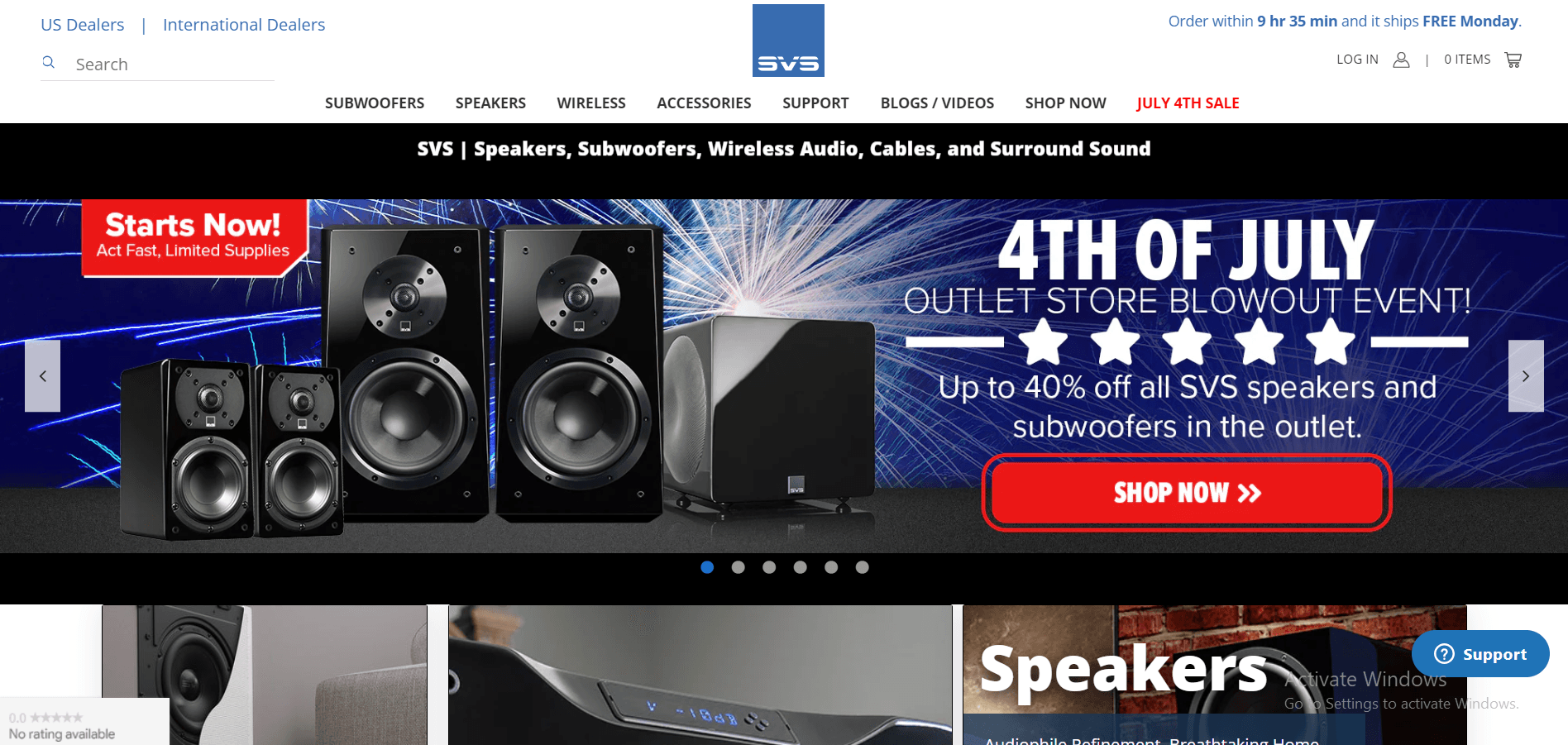
The SVS Sound website uses a customized Shopify theme and excels in several key areas:
-
High-quality images, detailed descriptions, and user reviews enhance the shopping experience.
-
An intuitive design and tools like the "System Builder" facilitate easy navigation and customization.
-
Blogs, videos, and FAQs provide valuable information, helping customers make informed decisions.
-
Multiple support channels, including live chat and email, ensure customers receive assistance when needed.
-
Features like free shipping and a 5-year warranty build trust and encourage purchases.
7.2. Factory Outlet
Next in line is Factory Outlet - a Shopify store specializing in high-quality gaming gear. This American store was built using Shopify's Kingdom theme.
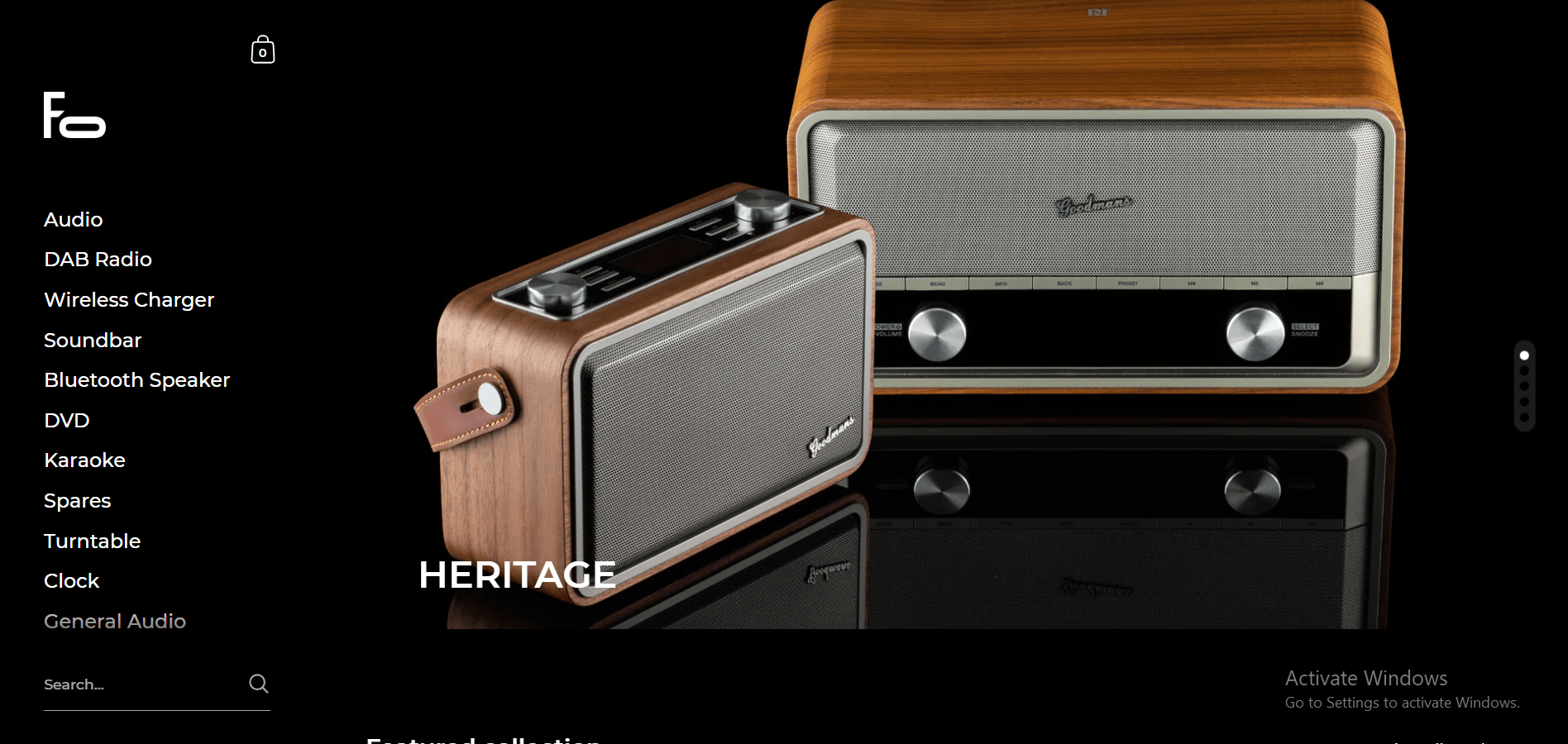
What they excel at:
-
The store features a modern, aesthetically pleasing design with an impressive color scheme.
-
It includes high-definition images and ample space for product displays and storytelling.
-
The large menu is equipped with intelligent search suggestions.
-
Detailed product descriptions allow customers to easily share product information online.
-
The store offers smart product suggestions in the “You may also like” section, as well as effective cross-selling products.
7.3. Wyze
Next, Wyze specializes in smart home products, particularly known for their security cameras and home automation systems.
The Wyze website exemplifies a well-organized and customer-focused approach.
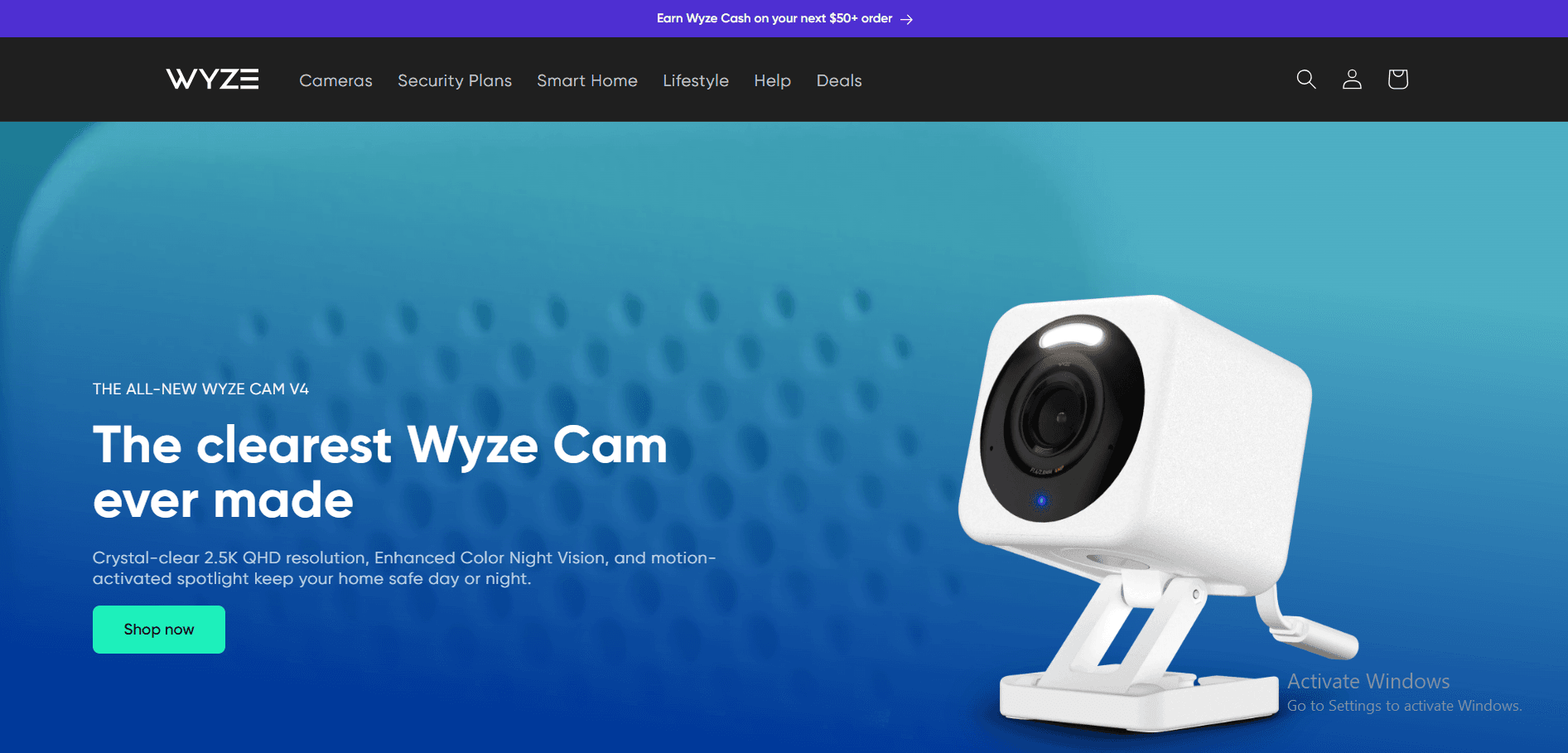 The store is built using Shopify and excels in several areas:
The store is built using Shopify and excels in several areas:
-
The website features a clean and straightforward design that makes it easy for customers to find products and information.
-
Each product page is equipped with high-definition images and detailed specifications, helping customers make informed decisions.
-
Detailed descriptions include technical specifications, usage scenarios, and compatibility information.
-
The search function provides intelligent suggestions and filters, improving the shopping experience.
-
The site includes comparison charts, user guides, and promotional videos that enhance product understanding and engagement.
-
The website is optimized for mobile devices, ensuring a seamless shopping experience across all platforms.
7.4. Quad Lock
Another great example is Quad Lock. Quad Lock's website appears to use a customized Shopify theme, optimized for functionality and user experience.
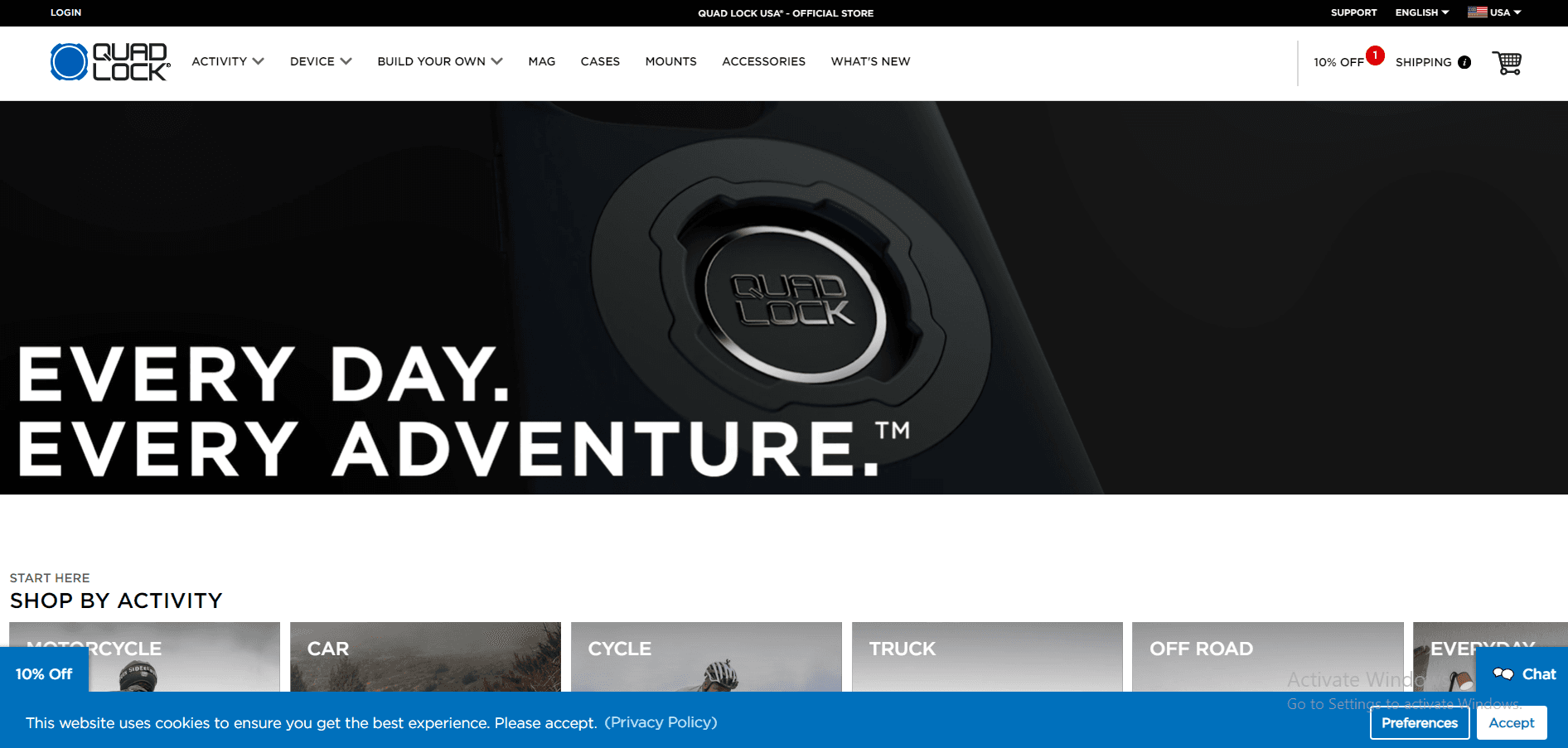
The site excels in several key areas:
-
The site offers a broad range of mounts and cases for various devices and activities, such as motorcycles, cars, bicycles, and running. Users can also build their own kits to match their specific needs.
-
The navigation is well-structured, with categories for different device.
-
The "360 Kit Builder" allows customers to customize their mounts, adding an interactive and engaging experience.
-
The website supports multiple regions and languages, enhancing accessibility for international customers.
-
Comprehensive support resources help customers make informed decisions and resolve any issues easily.
7.5. Ugreen
If you seek inspiration from an electronic device and accessory retailer, consider Ugreen. Ugreen, a prominent Shopify electronics store based in China, has successfully built its online presence using the Shopify Kalles theme.
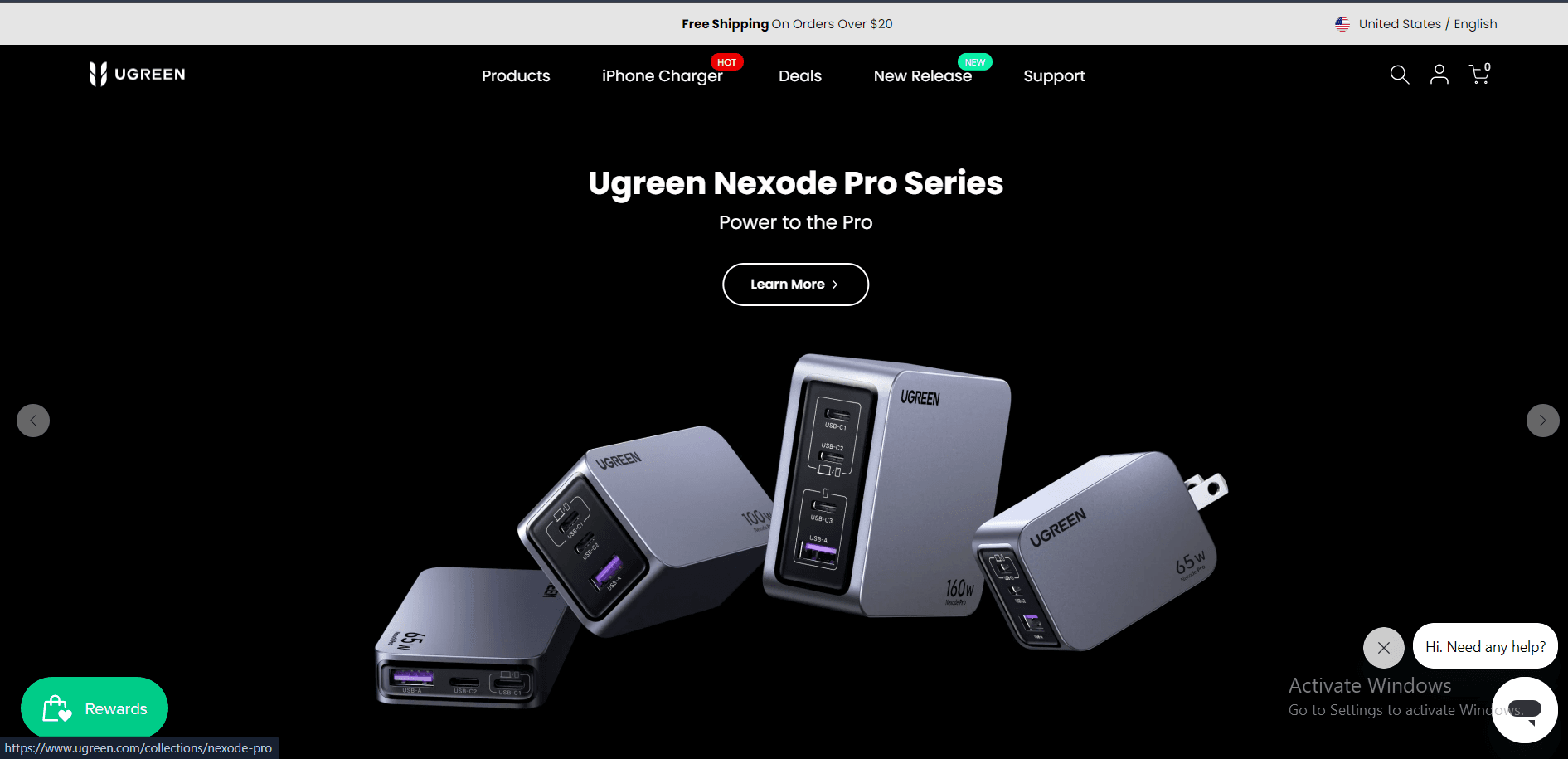
What they excel at:
-
A large menu that allows customers to browse the store’s products.
-
Encourage customers to create accounts on their website to boost loyalty and enhance the overall customer experience.
-
Excellent customer support by including a chat session on their homepage.
-
Detailed product descriptions and product comparisons provide valuable insights for website visitors.
-
In-menu promotions to boost sales and promote the hottest, best-selling products to customers.
That’s it. We have walked you through the list of the 5 great Shopify electronics store examples for you to get more insights and inspiration for your online business.
The next step is to take action & start building your own store.
Ready to elevate your Shopify store with ease and expertise? Discover TrueStoreFront's OWEN theme and professional developer assistance. Launch a stunning, high-performing online store quickly and efficiently, with support every step of the way.
Conclusion
In this guide, we've explored the comprehensive process of setting up a successful Shopify electronics store.
Shopify's robust platform provides all the tools and features necessary to build and scale an efficient and attractive online electronics store.
By leveraging Shopify's user-friendly interface, extensive app integrations, and dedicated customer support, you can create a seamless shopping experience that attracts and retains customers.
Read more:
